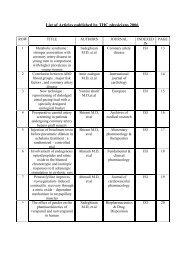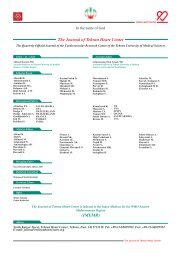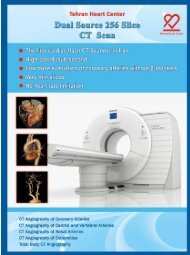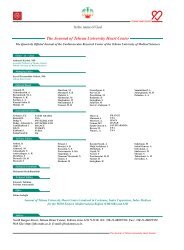THE JOURNAL OF TEHRAN UNIVERSITY HEART CENTER
THE JOURNAL OF TEHRAN UNIVERSITY HEART CENTER
THE JOURNAL OF TEHRAN UNIVERSITY HEART CENTER
Create successful ePaper yourself
Turn your PDF publications into a flip-book with our unique Google optimized e-Paper software.
The Journal of Tehran University Heart Center<br />
Gholamreza Yousefzadeh et al.<br />
Table 1. Demographic characteristics and clinical data of GDM versus non-GDM women *<br />
Characteristics<br />
GDM group<br />
(n=25)<br />
Non-GDM group<br />
(n=25)<br />
Age (y) 24.4±3.6 25.1±4.2 0.259<br />
Height (cm) 159.4±5.5 161.5±7.3 0.276<br />
Weight (kg) 72.8±11.5 68.7±10.9 0.225<br />
Body mass index (kg/m 2 ) 28.7±4.5 26.5±4.5 0.109<br />
Systolic BP (mm Hg) 110.0±9.4 107.6±8.0 0.369<br />
Diastolic BP (mm Hg) 69.0±10.4 65.2±8.5 0.192<br />
Serum HDL (mg/dL) 49.0±8.7 49.0±10.5 0.987<br />
Serum LDL (mg/dL) 140.7±37.4 137.7±36.0 0.780<br />
Fasting blood sugar (mg/dL) 85.3±13.7 83.2±19.8 0.680<br />
Serum triglyceride (mg/dL) 183.5±67.0 178.0±61.0 0.775<br />
Serum cholesterol (mg/dL) 219.0±54.7 223.8±43.8 0.746<br />
*<br />
Data are presented as mean±SD<br />
GDM, Gestational diabetes mellitus; BP, Blood pressure; HDL, High-density lipoprotein; LDL, Low-density lipoprotein<br />
P value<br />
Table 2. Differences in carotid IMT in GDM versus non-GDM women *<br />
CIMT<br />
Mid-term pregnancy<br />
(mm)<br />
Full-term<br />
pregnancy(mm)<br />
GDM group<br />
(n=25)<br />
Non-GDM group<br />
(n=25)<br />
P value **<br />
0.65±0.07 0.59±0.06 0.002<br />
0.65±0.05 0.59±0.04 < 0.001<br />
P value *** 0.989 0.992<br />
*<br />
Data are presented as mean±SD<br />
**<br />
Between groups comparison<br />
***<br />
Within groups comparison<br />
IMI, Intima-media thickness; GDM, Gestational diabetes mellitus; CIMT,<br />
Carotid intima-media thickness<br />
Discussion<br />
An increased carotid IMT can be observed not only in<br />
long-standing type II diabetic but also in newly detected type<br />
II diabetic patients. Especially in pregnant women, carotid<br />
IMT gradually increases from the first to the third trimester<br />
of normal pregnancy and regresses in the postpartum period.<br />
Nevertheless, the trend of the increase in pregnant women<br />
with gestational diabetes is still unclear. In our study, with the<br />
aid of carotid ultrasound, arterial examination was performed<br />
at mid-term and full-term pregnancy and both controls and<br />
the women with an impaired OGCT test were assessed<br />
and compared with regard to the changes in carotid IMT.<br />
We showed that although carotid IMT was more increased<br />
in those with impaired OGCT, the trend of this change was<br />
similar between the impaired and normal OGCT groups.<br />
Furthermore, we observed that carotid IMT was significantly<br />
higher in the diabetic group than in the normoglycemic<br />
group in different trimesters, but the trend of these gradual<br />
changes from the first to the third trimester was similar in<br />
both groups. Totally, effective glycemic control seems to be<br />
helpful for the prevention of increased carotid IMT.<br />
During the pregnancy period, peripheral vascular<br />
resistance is physiologically paralleled by improved<br />
macrovascular compliance. 11, 12 Some researchers have<br />
shown that 2-4 years after previous gestational diabetes<br />
mellitus, a significantly higher arterial stiffness can be<br />
found compared with reference women without a history of<br />
diabetes. 13 Pregnancies complicated by diabetes not only are<br />
associated with increased carotid IMT but also can lead to<br />
increased maternal arterial stiffness. 9<br />
This study demonstrates increased IMT of the carotid artery<br />
in a group of women who had a pregnancy complicated by<br />
impaired OGCT. This finding is in line with the literature<br />
confirming that women with a history of gestational diabetes<br />
have a higher risk of developing increased carotid IMT. This<br />
change can potentially lead to cardiovascular diseases in<br />
later life. There are some explanations for this phenomenon.<br />
One of the first steps in the development of atherosclerosis is<br />
endothelial activation, followed by endothelial dysfunction.<br />
Thus, in diabetes mellitus, vascular endothelial activation<br />
or dysfunction is considered to play a key role in the<br />
development of many of the clinical manifestations related<br />
to carotid artery disease, several years after delivery.<br />
Association between parity and carotid artery disease<br />
can be affected by some underlying factors. Some<br />
epidemiological studies have found positive associations<br />
between parity and risk of carotid artery plaques in elderly<br />
women and, therefore, age of pregnancy can be a trigger<br />
for this phenomenon. 14 Also, multi-gravidity and previous<br />
history of coronary diseases have been also identified to be<br />
related to the appearance of carotid artery plaques. 15 Folate<br />
deficiency during pregnancy is another probable triggering<br />
factor for progressing carotid IMT. Folate deficiency is<br />
linked with hyperhomocystinemia, 16 which is associated with<br />
accelerated progression of atherosclerosis 17 and, thereby,<br />
158
















